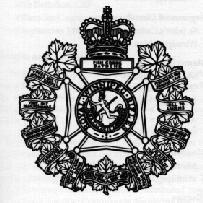|
|

They shall grow not old, as we that are left grow old

|
|
The Royal Winnipeg Rifles

Armorial Description
A maltese Cross with a tablet above surmounted by the Crown; on the centre of
the Cross a medallion edged by an annulus inscribed ROYAL WINNIPEG RIFLES; on
the medallion a naked black devil running on a scroll bearing the regimental
motto HOSTI ACIE NOMINATI; in the devil's right hand a trident and offering a
chalice with his left; encircling the Cross a wreath of maple leaves within a
spiral riband scroll inscribed with the battle honours which are placed in
pairs one over the other on each visible turning of the scroll; the battle
honours are as follows: on the tablet below the Crown, FISH CREEK and BATOCHE;
on the dexter side of the wreath from the top downward, YPRES, 1915,'17 and
MOUNT SORREL; VIMY 1917 and PASSCHENDAELE; DROCOURT-QUEANT and NORMANDY
LANDING; CARPIQUET and CALAIS, 1944; LEOPOLD CANAL and THE RHINE; on the
sinister side FESTUBERT, 1915 and SOMME, 1916; HILL 70 and AMIENS; CANAL DU
NORD and PUTOT-EN-BESSIN; FALAISE and THE SCHELDT; MOYLAND WOOD and N.W.
EUROPE, 1944-45; on the portion of the battle honour scroll on the base of the
wreath NORTH-WEST CANADA, 1885 and SOUTH AFRICA, 1899-1900.
Official Abbreviation: R Wpg Rif
Motto: Hosti Acie Nominati (Named by the enemy in battle)
Battle Honours (44)
Early History
FISH CREEK
NORTH-WEST CANADA, 1885
BATOCHE
SOUTH AFRICA, 1899,1900
First World War
YPRES, 1915,'17
Arleux
Gravenstafel
HILL 70
St. Julien
PASSCHENDAELE
FESTUBERT, 1915
AMIENS
MOUNT SORREL
Scarpe, 1918
SOMME, 1916
DROCOURT-QUEANT
Thiepval
Hindenburg Line
Ancre Heights
CANAL DU NORD
Arras, 1917,18
Pursuit to Mons
VIMY, 1917
France and Flanders, 1915-18
Second World War
NORMANDY LANDING
THE SCHELDT
PUTOT-EN-BESSIN
LEOPOLD CANAL
Caen
Breskens Pocket
CARPIQUET
The Rhineland
The Orne
Waal Flats
Bourguebus Ridge
MOYLAND WOOD
FALAISE
THE RHINE
The Laison
Emmerich-Hoch Elten
The Seine, 1944
Deventer
CALAIS, 1944
NORTH-WEST EUROPE, 1944-45
Order of Precedence: 28
Go back to the Infantry Regiments page.
Go back to the Army home page.
|
|
|
| |
BTDT : Been There, Done That. The person that has "been there, done that" in real time. Not someone from a school or course that has only learned the basics, in a class or by theory, but has lived the experience for real.
» Download the iPhone/iPad Military Terms app! «
|
|
| |
December 23
1900: The Second (Special Service) Battalion, The Royal Canadian Regiment arrives in Halifax from South Africa and is disbanded
1935: Italians begin using mustard gas in Ethiopia
» Download the iPhone/iPad Military History app! «
|
|
